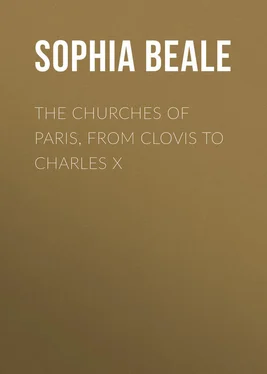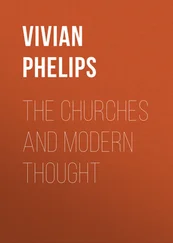Sophia Beale - The Churches of Paris, from Clovis to Charles X
Здесь есть возможность читать онлайн «Sophia Beale - The Churches of Paris, from Clovis to Charles X» — ознакомительный отрывок электронной книги совершенно бесплатно, а после прочтения отрывка купить полную версию. В некоторых случаях можно слушать аудио, скачать через торрент в формате fb2 и присутствует краткое содержание. Жанр: foreign_antique, foreign_prose, на английском языке. Описание произведения, (предисловие) а так же отзывы посетителей доступны на портале библиотеки ЛибКат.
- Название:The Churches of Paris, from Clovis to Charles X
- Автор:
- Жанр:
- Год:неизвестен
- ISBN:нет данных
- Рейтинг книги:3 / 5. Голосов: 1
-
Избранное:Добавить в избранное
- Отзывы:
-
Ваша оценка:
- 60
- 1
- 2
- 3
- 4
- 5
The Churches of Paris, from Clovis to Charles X: краткое содержание, описание и аннотация
Предлагаем к чтению аннотацию, описание, краткое содержание или предисловие (зависит от того, что написал сам автор книги «The Churches of Paris, from Clovis to Charles X»). Если вы не нашли необходимую информацию о книге — напишите в комментариях, мы постараемся отыскать её.
The Churches of Paris, from Clovis to Charles X — читать онлайн ознакомительный отрывок
Ниже представлен текст книги, разбитый по страницам. Система сохранения места последней прочитанной страницы, позволяет с удобством читать онлайн бесплатно книгу «The Churches of Paris, from Clovis to Charles X», без необходимости каждый раз заново искать на чём Вы остановились. Поставьте закладку, и сможете в любой момент перейти на страницу, на которой закончили чтение.
Интервал:
Закладка:
Not only was S. Denis specially favoured by this miraculous dedication, but it was privileged by Charlemagne in a charter, as the chief and mistress of all the churches in the kingdom; and its abbot as the Primate of all the prelates of France. This great man was allowed to have six deacons vested in dalmatics whenever he officiated, an honour conferred upon him by Pope Stephen III. when he consecrated the High Altar in 753, and at the same time anointed and crowned King Pépin and Queen Bertrade, and their two sons Charles and Carloman. People, high and low, from all the ends of the earth, flocked to the famous abbey as we now rush to the World's Fairs; and the great ones of the earth, princes, nobles, and ambassadors, considered that they had seen nought of the civilised world if they had not paid their respects to the relics at S. Denis. Some went for love, some out of sheer curiosity to see the riches of the treasury: divers crosses, reliquaries, statues, vases, chalices, and other vessels for the altars; S. Denis' mitre, chalice, and rings; the famous head of solid silver gilt, containing his skull, and presented to the abbey by Marguerite de France in 1360; a wonderful golden cup enriched with precious stones which had belonged to King Solomon, and a rock crystal vase from the Temple of the wise man – both the gift of Charles the Bald. He, being abbot, made it his custom to attend "the duties of his station at the Abbaye, on the solemn festivals, passing the day in pious conversation with the monks and in religious observances." He also made considerable donations, 10 10 All the river Seine from the ru de Séve (Sèvres) near S. Cloud, to S. Germain-en-Laye.
added to the many lamps which are kept continually burning before the shrines, and increased the number of wax tapers employed in the services of the church. Then further, amongst the curiosities, were the nail of a griffin upon a silver-gilt animal; a unicorn's horn six feet high, sent by Aaron King of Persia to Charlemagne; the hunting horn of Roland, nephew of Charlemagne; and the lantern which was used at the betrayal of our Lord in the Garden, called the Lantern of Judas. The latter was of copper, embellished by rock crystal, through which the light shone. (This was also the gift of Charles the Bald). The mirror of the prince of poets, Virgil, which was of jet; the sword of the genereuse Amazone, Jeanne la Pucelle . Of the beauty of the croziers and pastoral crosses, the mitres and episcopal rings, Dom Millet's description leaves no doubt; and of the magnificence of the abbots, and the splendour of their monastery, we have more than ample evidence. As an old epigram puts it:
Au tems passé du siècle d'or,
Crosse de bois , Evêque d'or,
Maintenant changent les lois,
Crosse d'or, Evêque de bois .
The Huguenots destroyed many of the church ornaments, ruined chapels, and worse still, "ces impies la pillerent (S. Denis) et dissiperent entierement, sans y laisser aucune chose, sinon ce qu'ils ne voulutent point. Ils ne pouuoient faire pis, sinon mettre le feu par tout le Monastere, comme ils firent en tant d'autres par la France." It was supposed that the "Prince de Condé, leur chef," was not present at these little pastimes of his valiant soldiers, for when he heard what had been done "il fit pendre vne douzaine, pour monstrer comment il detestoit leur sacrilege: mais pour cela les pertes ne furent pas reconnettes."
In a History of the Royal Abbaye of Saint Denis , published in London in 1795, we have some curious details connected with the church. "Every Sunday and Holy Day at mass, the Deacons and Sub-deacons, after having received the 'precious body of Our Lord,' repaired to a side altar to suck up through a reed, enclosed in a tube of enamelled gold, the 'precious blood,' according to a very ancient custom adopted in the church of S. Denis, which is retained without any variation to this day." Whether this was so, or whether it was the result of the anonymous writer's imagination, I cannot say, as I find nothing about it in other books that I have studied.
The same author speaks of the "miraculous silver keys of S. Denis which they apply to the faces of those persons who have been so unfortunate as to be bitten by mad dogs, and who receive a certain and immediate relief by only touching them." Alas, that these keys should have been melted up; for here was a cure for hydrophobia without any of the vicarious suffering which M. Pasteur's discovery has caused.
The legend of S. Denis, the patron of France, is exceedingly picturesque. By some ecclesiastical authorities he is said to have lived in the 1st century, by others in the 2nd or 4th, but by most he is one and the same person as Dionysius the Areopagite. Hilduin, abbot of S. Denis at the beginning of the 9th century, seems to have had no doubt upon the subject, and in art the Saint and the disciple of S. Paul have always been looked upon as the self-same personage, although tradition records the existence of another S. Denis, a bishop of Paris, in the 3rd century. Dionysius was an Athenian philosopher named Theosophus. Travelling in Egypt to study astrology with a companion named Apollophanes, they were surprised by a strange darkness that came over the heavens, and were naturally much troubled thereby. Returning to Athens, Dionysius heard S. Paul preach, and thereupon being converted to Christianity, he understood that the darkness which he had seen at Heliopolis was none other than that which fell upon the earth for the space of three hours when the Blessed Redeemer was crucified. Baptised and ordained priest, Dionysius subsequently became bishop of Athens; and in some of the writings attributed to him he relates that he travelled to Jerusalem to see the Blessed Virgin, whom he found continually surrounded by a dazzling light, and attended by a company of Angels. He also gives an account of her death at which he was present with certain of the Apostles. After this, he returned to Athens and was subsequently present at S. Paul's martyrdom in Rome. Thence he was sent by S. Clement to preach the Gospel, together with a priest named Rusticus, and a deacon Eleutherius. Arrived at Paris, an exceeding great city full of people and provided with all the good things of the earth, they found it so attractive that it seemed to them another Athens, and so they sojourned there, teaching the people, who were learned in all things but the way of truth. S. Denis then sent missionaries into other parts of Gaul, and into Germany. But these successes were not pleasing unto Satan, and so he stirred up the nobles against the good bishop, who was accused before the Emperor Trajan. Some say it was Domitian, but in either case the result was the despatch of one Frescennius, a pro-consul, from Rome, with orders to throw Denis and his companions into prison. This was done, and finding that they would not retract, they were put to death upon the Hill of Mercury (who was so much honoured by the Gauls), and which was subsequently called Montmartre ( Mons Martyrum ).
"Le Saint evêque Denis, et ses deux compagnons, le prêtre Rustique et le diacre Eleuthère, souffrirent leur mémorable et très-glorieuse passion, à la vue de la cité des Parisiens, sur la colline qui se nommait auparavant Mont de Mercure, parce que cette idole y était particulièrement honorée de Gaulois, et qu'on appelle aujourd'hui le Mont des Martyrs en mémoire des saints du Seigneur qui accomplirent en ce lieu même leur martyre triomphal." 11 11 Hulduin, abbot of S. Denis, commencement of 9th century, who took possession the same day as that upon which Charlemagne died. — Les Areopagitiques.
Then a stupendous miracle took place. S. Denis not desiring, or not being permitted, to become food for wolves, took up his decapitated head in his hands, and walked for the space of two miles, Angels singing by the way. Accompanied by this celestial body-guard, the Saint marched over the plains beyond the city, and signified, in some way unrecorded, that he desired burial where now stands the church dedicated to his memory. This was accomplished by a pious woman named Catulla, who had ministered unto the three blessed martyrs in their prison, and who now laid their mutilated remains in her own field.
Читать дальшеИнтервал:
Закладка:
Похожие книги на «The Churches of Paris, from Clovis to Charles X»
Представляем Вашему вниманию похожие книги на «The Churches of Paris, from Clovis to Charles X» списком для выбора. Мы отобрали схожую по названию и смыслу литературу в надежде предоставить читателям больше вариантов отыскать новые, интересные, ещё непрочитанные произведения.
Обсуждение, отзывы о книге «The Churches of Paris, from Clovis to Charles X» и просто собственные мнения читателей. Оставьте ваши комментарии, напишите, что Вы думаете о произведении, его смысле или главных героях. Укажите что конкретно понравилось, а что нет, и почему Вы так считаете.




![Theresa Cheung - The Dream Dictionary from A to Z [Revised edition] - The Ultimate A–Z to Interpret the Secrets of Your Dreams](/books/692092/theresa-cheung-the-dream-dictionary-from-a-to-z-r-thumb.webp)







